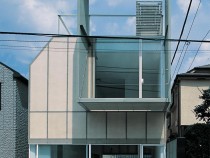
© Mitsumasa Fujitsuka/helico
The house was designed for a photographer and is located in a densely built residential area. Its form was largely determined by statutory requirements and building lines. Based on a concept of openness, the house is distinguished by large areas of glazing on the ground floor. The photo studio is situated in the basement. The flat roof, which affords a view over the city, is also used as an open-air studio and for parties, as well as for tea ceremonies, which are held on the rear terrace area for friends of the client. Plastic was chosen as the appropriate material for this building in order to achieve the required qualities of lightness and openness. It was also seen as a fitting response to the chaotic urban surroundings. The architect was further attracted by the opportunity of experimenting with different kinds of plastic and developing new details for this material. The walls facing on to the street and the garden are finished internally and externally with fibre-reinforced plastic panels, with an intermediate layer of translucent thermal insulation. In this way, the bedrooms enjoy a link with the outside world without any loss of privacy. Similarly, the plastic strips to the garden fence, the veranda and balcony provide both screening and openness. Many other details, from the staircase treads to certain fixings, were also executed in plastic. For pragmatic reasons, however, the load-bearing structure is in steel.







